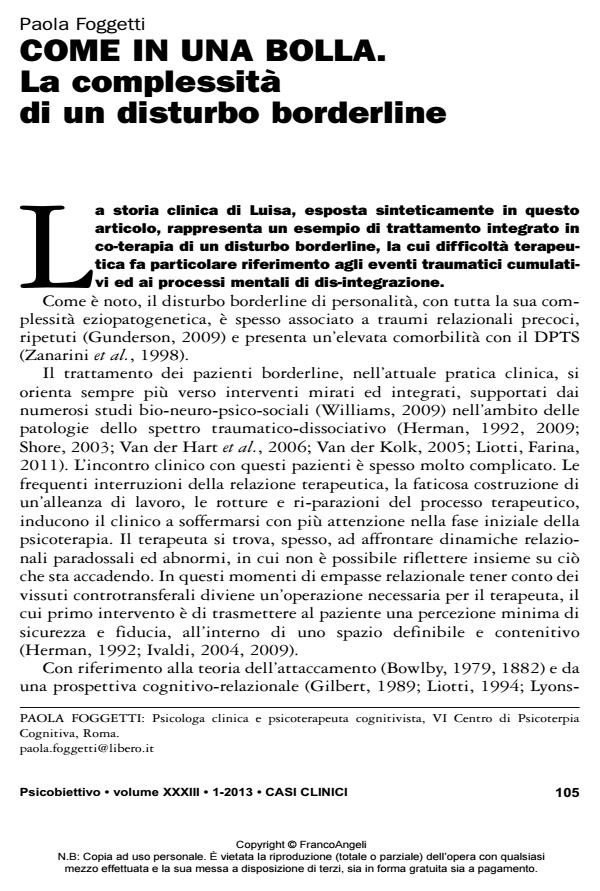Come in una bolla. La complessità di un disturbo borderline
Titolo Rivista PSICOBIETTIVO
Autori/Curatori Paola Foggetti
Anno di pubblicazione 2013 Fascicolo 2013/1
Lingua Italiano Numero pagine 14 P. 105-118 Dimensione file 248 KB
DOI 10.3280/PSOB2013-001008
Il DOI è il codice a barre della proprietà intellettuale: per saperne di più
clicca qui
Qui sotto puoi vedere in anteprima la prima pagina di questo articolo.
Se questo articolo ti interessa, lo puoi acquistare (e scaricare in formato pdf) seguendo le facili indicazioni per acquistare il download credit. Acquista Download Credits per scaricare questo Articolo in formato PDF

FrancoAngeli è membro della Publishers International Linking Association, Inc (PILA)associazione indipendente e non profit per facilitare (attraverso i servizi tecnologici implementati da CrossRef.org) l’accesso degli studiosi ai contenuti digitali nelle pubblicazioni professionali e scientifiche
Con riferimento ai recenti studi sul trauma complesso ed alle patologie dello spettro traumatico-dissociativo, presentiamo il percorso terapeutico di una paziente borderline con sintomi dissociativi di distacco e compartimentazione. All’interno di una cornice integrata cognitiva-relazionale, un particolare accento viene dato alle prime fasi della terapia, in cui le dinamiche dell’attaccamento disorganizzato e delle strategie controllanti, contrastano fortemente la costruzione di un contesto terapeutico protettivo e cooperativo.
Parole chiave:Trauma complesso; attaccamento disorganizzato; strategie controllanti; alleanza terapeutica
- Liotti G., Farina B. (2011) Sviluppi traumatici. Eziopatogenesi, clinica e terapia della dimensione dissociativa, Raffaello Cortina, Milano
- Lyons-Ruth K., Jacobvitz D. (1999) La disorganizzazione dell’attaccamento: perdite non elaborate, violenza relazionale e cadute nelle strategie comportamentali e attentive, in Cassidy J., Shaker P.R. (a cura di), Manuale dell’attaccamento. Teoria, ricerca e applicazioni cliniche, Giovanni Fioriti, Roma
- Lyons-Ruth K., Jacobvitz D. (2008) Attachment disorganization: Genetic factors, parenting contexts, and developmental transformation from infancy to adulthood, in Cassidy J., Shaver P. (a cura di), Handbook of Attachment: Theory, Research and Clinical Application, Guilford Press, New York, pp. 666-697
- Main M., Hesse E. (1990) Parents’ unresolved traumatic experiences are related to infant disorganized attachment status: Is frightened/frightening parental behavior the linking mechanism?, in Greenberg M., Cichetti D., Cummings M. (a cura di), Attachment in the Preschool Years, University of Chicago Press, Chicago, pp. 121- 160
- Schore A.N. (2001a) “The effect of a secure attachment relationship on right brain development, affect regulation, and infant mental health”, Infant Mental Health Journal, 22: 7-66
- Schore A.N. (2001b) “The effect of relational trauma on right brain development, affect regulation, and infant mental health”, Infant Mental Health Journal, 22: 201-269
- Schore A.N. (2001c) The right brain as the neurobiological substratum of Freud’s dynamic unconscious, in Scharff D. (a cura di). The Psychoanalytic Century: Frued’s Legacy for the Future, The Other Press, New York, pp. 61-88
- Shore A.N. (2003b) La regolazione degli affetti e la riparazione del sé, Astrolabio, Roma
- Van der Hart O., Nijenhuis E.R.S., Steele K. (2006) Fantasmi del sé. Trauma e trattamento della dissociazione strutturale, Raffaello Cortina, Milano
- Van der Kolk B.A., McFarlane A.C. (1996) Il buco nero del trauma, in Van der Kolk B.A., McFarlane A.C., Weisaeth L. (a cura di), Stress traumatico. Gli effetti sulla mente, sul corpo e sulla società delle esperienze intollerabili, Magi, Roma, pp. 225-249
- Van der Kolk B.A. (2005) Il disturbo traumatico dello sviluppo: verso una diagnosi razionale per i bambini cronicamente traumatizzati (trad. it. In Caretti V., Craparo G. (a cura di), Trauma e Psicopatologia, Astrolabio, Roma, pp. 81-93)
- Williams R. (a cura di) (2009) Trauma e relazioni. Le prospettive scientifiche e cliniche contemporanee, Raffaello Cortina, Milano
- Zanarini M.C. et al. (1998) “Axis I comorbidity of borderline personality disorder”, American Journal of Psychiatry, 155: 1733-1739
- Bateman A., Fonagy P. (2004) Il trattamento basato sulla mentalizzazione. Psicoterapia con il paziente borderline, Raffaello Cortina, Milano
- Bowlby J. (1979) Costruzione e rottura dei legami affettivi, Raffaello Cortina, Milano
- Bowlby J. (1982) Attaccamento e perdita, vol. 1., Boringhieri, Torino
- Bowlby J. (1982) Attaccamento e perdita, vol. 2., Boringhieri, Torino
- Bromberg P.M. (2006) Destare il sognatore. Percorsi clinici, Raffaello Cortina, Milano
- De Bellis M.D. (2010) Neurobiologia della trascuratezza infantile, in Lanius-Ruth A., Vermetten E., Pain C. (a cura di), L’impatto del trauma infantile sulla salute e sulla malattia. L’epidemia nascosta, Giovanni Fioriti, Roma
- Di Maggio G., Semerari A. (2003), I disturbi di personalità. Modelli e trattamento, Laterza, Roma-Bari
- Gilbert P. (1989) Human nature and suffering, LEA, London
- Gunderson J.G. (2009) “Borderline Personality Disorder: Ontogeny of a diagnosis”, American Journal of Psychiatry, 166, 5: 530-539
- Fink G.R. et al. (1996) “Cerebral representation of one’s own past: Neural networks involved in autobiographical memory”, Journal of Neuroscience, 16: 4275-4282
- Herman J.L. (2009) Il disturbo post-traumatico da stress complesso, in Williams R. (a cura di), Trauma e Relazioni. Le prospettive scientifiche e cliniche contemporanee, Raffaello Cortina, Milano
- Herman J.L. (1992) Guarire dal trauma, Magi, Roma, 2005
- Ivaldi A. (2004) “Il triangolo drammatico: da strumento descrittivo a strumento terapeutico”, in Associazione di Psicologia Cognitiva (a cura di), Rivista Cognitivismo Clinico, I, 2, Giovanni Fioriti, Roma
- Ivaldi A. (2009) Due stanze per la terapia: un trattamento ambulatoriale di psicoterapia integrata. Tra il modello cognitivo-evoluzionista e la psicoanalisi contemporanea, in Ivaldi A., Foggetti P., Aringolo K. (a cura di), Disturbi di personalità e relazione: giochi polifonici tra le parti. Linee di sviluppo e modelli di intervento, FrancoAngeli, Milano
- Lineahn M.M. (1993) Il trattamento cognitivo-comportamentale del disturbo borderline. Il modello dialettico, Raffaello Cortina, Milano
- Liotti G. (1994/2005) La dimensione interpersonale della coscienza, Carocci, Roma
Paola Foggetti, Come in una bolla. La complessità di un disturbo borderline in "PSICOBIETTIVO" 1/2013, pp 105-118, DOI: 10.3280/PSOB2013-001008